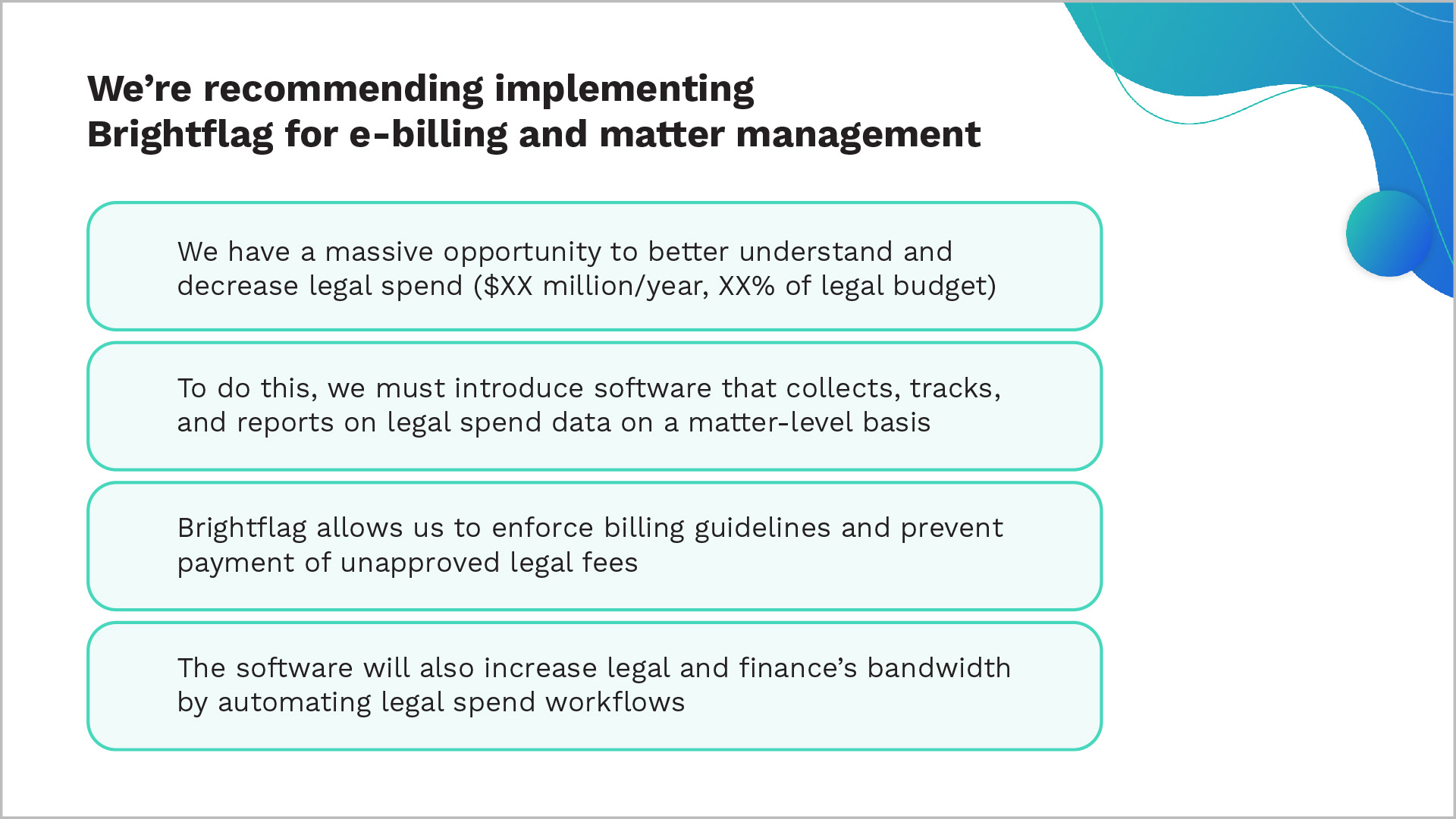6 Elements Every Legal Technology Business Case Needs
Developing a compelling legal technology business case for the software tool(s) your in-house team needs can take time. You’ll not only need an in-depth knowledge of the stakeholders in your organization that are involved in the buying process and what they value. But you’ll also need to craft a concise-yet-impactful presentation that you can bring to those stakeholders to secure buy-in for the purchase.
You don’t have to start from scratch when it comes to building that legal technology business case, though. In fact, here at Brightflag we’ve leveraged our experience helping hundreds of legal teams successfully build a business case for e-billing and matter management software to create the Legal Technology Business Case Guide.
If you don’t have time to peruse the full guide though, here are six key elements that every successful legal tech business case should include:
1. Executive Summary
When presenting your business case, you should begin with an executive summary—a high-level overview of the major pain point(s) your in-house team is experiencing, or the business objectives they’re hoping to accomplish. The summary should also touch on how the legal tech tool you’re considering can help.
It’s important to mention that your business case should be tailored to the priorities of whichever stakeholder you’re presenting to. For example, your presentation—and, consequently, your executive summary—should change based on whether you’re speaking to your General Counsel or your Chief Financial Officer.
Also note that, because this slide will be summarizing much of the information referenced later in your business case, you’ll actually fill in the details of it last.
Here’s an example of what this slide oftentimes looks like for organizations making the case for Brightflag:

2. The Problems We’re Experiencing
While nobody wants to give a presentation on the things going wrong in the department, it is important to highlight the areas where efficiencies can be created, money can be saved, and/ or workflows can be improved.
For this slide, draw attention to the issues your legal team and wider organization are experiencing. Pull in the names of the people impacted by these pain points and specific examples of the issues they’re facing to ground them in reality.
Examples:
• “Our attorneys are spending X hours per week on low-value work like reviewing invoices.”
• “Our outside counsel guidelines are not being enforced, which is impacting our ability to control legal costs.”
3. Why We Need to Solve Them Now
All of your stakeholders are busy people who are juggling numerous priorities. So build urgency by underscoring how pressing the issues are, and what might happen as a result of inaction.
The more you tie this argument back to your top-level objectives as an in-house team, and as a company, the more your case will resonate.
Examples:
• “Our annual objective is to reduce legal spend by X%, and we need a plan and solution in place in order to achieve this.”
• “Attorney sentiment is low and we’re at risk of attrition if we don’t help them reduce and/or streamline their workloads.”
4. What the Future Looks Like
Outline the changes that the legal department (and the organization as a whole, where applicable) will experience as a result of having this legal tech solution in place. This is where you’ll paint a picture of how much better things will be once the solution is implemented.
5. Why We’re Recommending This Legal Tech Provider
Call out the features that make the tech provider you’ve chosen stand out. For example, do they offer top-of-the-line AI functionality? Are they lauded for their customer service?
Pull in examples of companies similar to yours that saw results. This is where quotes and data gathered from customer reviews, recommendations, and case studies will really stand out. Your preferred vendor’s website can be a great resource for this information.

6. ROI Breakdown
Work with your legal tech vendor of choice to pull insights on potential cost savings and provide an in-depth breakdown of where savings will come from. Common areas of cost savings we see realized with Brightflag include: Spend reduction and avoidance Increased productivity through automation Improved financial planning and accounting
More Tips for Building an Effective Legal Tech Business Case
These elements will provide a strong foundation upon which you can build a convincing legal technology business case. However, there are many other considerations to keep in mind when navigating the buying process if you want to secure approval to make a purchase.
For our full breakdown of how to build the strongest legal technology business case possible, be sure to check out our comprehensive Legal Technology Business Case Guide.


